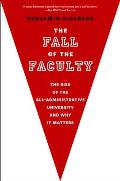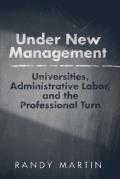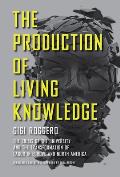- About
- Programs
- Issues
- Academic Freedom
- Political Attacks on Higher Education
- Resources on Collective Bargaining
- Shared Governance
- Campus Protests
- Faculty Compensation
- Racial Justice
- Diversity in Higher Ed
- Financial Crisis
- Privatization and OPMs
- Contingent Faculty Positions
- Tenure
- Workplace Issues
- Gender and Sexuality in Higher Ed
- Targeted Harassment
- Intellectual Property & Copyright
- Civility
- The Family and Medical Leave Act
- Pregnancy in the Academy
- Publications
- Data
- News
- Membership
- Chapters
Losing Our Faculties
The Fall of The Faculty: The Rise of the All-Administrative University and why it Matters. Benjamin Ginsberg. New York: Oxford University Press, 2011.
Under New Management: Universities, Administrative Labor, and the Professional Turn. Randy Martin. Philadelphia: Temple University Press, 2011.
The Production of Living Knowledge: The Crisis of the University and the Transformation of Labor in Europe and North America. Gigi Roggero (trans. Enda Brophy). Philadelphia: Temple University Press, 2011.
It’s hardly news that academia is in perpetual crisis, but to judge from a spate of recent books, we’ve reached a tipping point. The latest books on the state of higher education evoke both sadness and anger, particularly for a gray-bearded baby boomer with enough historical perspective to remember when everyone respectfully called my boyhood friend’s father, a professor at a tiny local liberal arts school, Doctor Rockwood. When I went off to an ivy-covered Gothic Revival campus, the stained-glass windows glowed with the quasi-sacred dignity of the life of the mind, and the soaring arches seemed the portal to a fulfilling life of thoughtful and cosmopolitan citizenship.
As that quaint vision recedes, critics of higher education fall into two camps: those who believe that the university has shortchanged society and those who think that society has shortchanged the university. The books surveyed here align with the latter faction. Their common core is an urgent wake-up call to the subversion and usurpation of faculty power and autonomy. While acknowledging that our syndrome has many symptoms, most focus on one cluster: the professoriate’s progressive loss of authority over curriculum, hiring, tenure, and promotion; over institutional purpose; and over our own working conditions. The authors range in tone from impassioned political analysis (Randy Martin) to ironic bemusement (Benjamin Ginsberg). Ginsberg provides frequent anecdotes from his own experience, while Gigi Roggero eschews examples for a jargon-heavy and historiographic but blistering sociological critique. All concur that academia, once widely treasured for its perch above worldly pressures, now operates more like a corporation than an ivory tower.
These diagnosticians probe three sore points: power, ideas, and money. First is the mushrooming of powerful administrators and their creeping takeover of the higher education agenda. This is Ginsberg’s strong suit: The Fall of the Faculty brims with absurdist cynicism over managerial bloat that has come at the expense of actual teaching. He labels these newly created administrators “deanlets”: professional managers who often do not come from an academic background and thus favor public relations over pedagogy.
In the region of ideas, according to Ginsberg, what hurts are the sweeping changes in curriculum and teaching, mainly toward vocational courses and instructional technology, initiated by those deanlets in response to outside pressures. The debate is between education and training: is college an apprenticeship for informed public participation or a store selling competitive private credentials? The pain lies not only in the changes themselves—which reflect a major shift in public perception of education—but in the fact that it is no longer educators who decide what students should know, as opposed to what the business model wants them to know (or not know).
As for money matters, business forces are restructuring the college workplace, aiming to turn the ivory tower into a factory. Salaries stagnate even as demands increase for accountability, spawning time-consuming forms and reports and the dreaded insistence on “outcomes assessment.” And that’s for those with a “real” job. The drastic reduction in tenured positions has reached the point where, at my school, more than half of all classes are taught by adjuncts.
What needs to be understood, if any headway is to be made in countering these trends, is that this infection in the US academy is but one outbreak of a broader epidemic: the penetration of American society by the values and methods of the increasingly global, late-capitalist social-economic order. Roggero’s analysis of mounting inequality in labor relations uncovers similar processes in Europe and Israel. Wherever they look, these authors find the same problems, and they use common terms for understanding this brave new world:
- Privatization: The transfer of universally accessible public services into the realm of private enterprise for profit, largely through cuts in government budgets.
- Corporatization: The increasing tendency to define every enterprise as if it were a profit-making corporation competing for a market of consumers. Hence colleges, like beer or baseball, strive for brand recognition, bragging rights, and customer satisfaction.
- Managerialism: The mode of organization intended to maximize productivity in all sectors of an enterprise by coordinated oversight and evaluation based on unquestioning faith in quantifiable “outcomes.” In the interest of efficient control, governing structures are hierarchical, bureaucratized, and secretive.
- Deprofessionalization: A new attitude toward specialized knowledge, which aims to discredit or eliminate all independent expertise and subject it to management-generated criteria. Insurance companies now overrule doctors; deanlets ignore faculty recommendations.
- Contingent labor: The result of the transformation of jobs that once promised full long-term employment into part-time positions adjustable to changing demand. Martin calls this process “casualization,” underscoring “the minimal commitment of institution to employee.”
- Precaritization: The deliberate creation of permanent insecurity and anxiety among workers by cutting jobs and reducing salaries along with health care, pensions, and other benefits. See also: proletarianization, Dickensian, social pathology.
This new regime is repugnant to academics not only for self-interested economic reasons but also viscerally, because it blasphemes the values and practices of the university, traditionally conceived as a service to the common good. Deconstructing the battles over workplace culture reveals profoundly different goals, philosophies, and worldviews. Just ask yourself which side you favor in James Truslow Adams’s venerable adage, “There are two types of education: one teaches you how to make a living, the other teaches you how to live.”
That difference is between two models of human interaction and power relations—the corporate and the cooperative—which embody mutually hostile conceptions of human nature and potential. The hierarchical, mechanistic managers mistrust every individual as fallen, lazy, and selfish; they seek power over the anarchic masses. In contrast, the idea of a college—a term, like colleague and collegial, rooted in “bound together” for common purpose—is collective and communitarian. It is grounded in the belief that people are basically good and should be given power to bring out—“e-duce”—their unique potentials, thus maximizing the shared welfare of all. In this guild paradigm, one is a long-term, active member, not an alienated part-timer, and a faculty, whose integrity is safeguarded by our commitment as an honorable “profession” (a religious term) to maintaining public trust, is granted autonomy and influence based on its specialized expertise.
Most academics I know have some sense of that “vocation,” of being called to a higher purpose. We wear the same robes as our clerical forebears when celebrating our secular priesthood of knowledge and reason. But for preaching that education is for public citizenship, not private productivity, we are now besieged by an inquisition-cum–hostile takeover. The managerial strategy is to surround and blockade, cutting off all aid and supplies to propel surrender in the face of starvation. For the ivory tower, that means choking off public funds, stripping us of the robes of authority, and undermining public sympathy for the professoriate, represented as a bunch of expensive, meddlesome, and unaccountable slackers.
Examinations of academia are often long on diagnosis and short on treatment. What do these researchers prescribe? Ginsberg is pessimistic about the future; both he and Martin seek to balance adjustments that both faculty and administration might reasonably make. All three offer a limited menu of suggestions, which probably have mixed chances of success. Mary Burgan, in her 2006 book What Ever Happened to the Faculty, usefully introduced two principal arenas of action—college governance institutions and labor unions—and all of the authors under consideration here take professors to task for their disengagement from faculty senates, committees, and other sites that offer at least some platform for both meaningful cooperation and resistance. They’re right. Most of us avoid such service—and not only because we know that despite lip service to “community,” it won’t get you tenure. Many are bitterly frustrated to discover that their local managerial juggernaut is already unstoppable. I once chaired a task force to investigate whether faculty were unduly pressured into, and inequitably rewarded for, prestige research—even as our president was planning to ratchet up those demands. In our campus survey, most felt teaching and service deserved greater weight, and I duly reported the junior faculty’s message that, if quotas increased, they would seek work elsewhere. Madame President’s blunt reply: “Let them try. There’s nowhere else to go.” Such snarling realpolitik is engendering a rise in union activism: if they are going to treat us like labor, we need to respond like labor.
Most of the proposals offered by these authors are well intentioned but small bore. We can’t solve the structural problems of higher education within the gates of our own quad; our only hope is to change priorities in society at large, ultimately a political task. Faculty unions have already marched with labor coalitions to demand our shared goal of economic justice, as my City University of New York group did recently. But educators also face a more abstract lobbying challenge unique to our job description. Martha C. Nussbaum’s eloquent defense of traditional liberal arts in Not for Profit argues (in the publisher’s pithy blurb) that “we must resist efforts to reduce education to a tool of the gross national product. Rather, we must work to reconnect education to the humanities in order to give students the capacity to be true democratic citizens of their countries and the world.” Amen—but how do we “broadcast our pitch” past the corporate-sponsored and radically segmented mass media? How can we convince our students, legislators—indeed, anyone who will listen—that knowledge is not a product, college is not an assembly line, and students are not just future worker bees? For what is at stake in the current academic wars is, quite starkly, the nature of our still nominally democratic society.
It is clear from these books that, if the present disease metastasizes, our national prognosis is cancerous inequality of education, wealth, political agency, and overall opportunity, squeezing the mass of citizens closer to the desperate misery that drove a Tunisian fruit vendor to set off last year’s Arab Spring by immolating himself. Our society is increasingly sacrificing the long-term future of all, disinvesting in sources of public well-being like education while enabling huge short-term profits for a few. Perhaps this backward step is feeding the current pop-culture fascination with the vampire: an unfeeling aggressor who sucks the lifeblood out of others so it can feast forever. There’s a name for such societies: “banana republic.” A good working definition, adapted from the one offered by the late social critic Christopher Hitchens in Vanity Fair, is a country operated as a commercial enterprise for private profit, reinforced by collusion between the state and favored corporations, through which the profits from private exploitation of public resources remain private property and the debts incurred become public responsibility. Because of corporate manipulation, the government is unaccountable to its citizens, and the legislature is for sale and functions mostly as a ceremonial rubber-stamp.
Sound familiar? That’s why so many people occupied Wall Street (and beyond) last fall, trying to broadcast the pitch that the corporate-technocratic 1 percent are stealthily entrenching a system in which no one will be able to challenge their greedy domination. They have already driven America’s universities, once a magnet for students from around the world, down the path toward becoming underfunded, micromanaged trade schools that fewer and fewer can afford. Soon the 99 percent won’t have any education in the full sense, not to mention a secure job or social safety net, that might enable them to look up from the struggle for survival and survey the causes of their plight. How ironic that, in a nation whose political rhetoric and institutions are unusually religious, the elite should be so contemptuous of Judeo-Christian ideals of equality, charity, and brotherly love. There are no Good Samaritans on Wall Street. Unchecked, they will transmute faculty into “human capital,” students from citizens into robots and consumers—all sucked dry, by ceaseless worry and crisis, of the energy for social activism. Anyone else remember the chilling line from Star Trek, intoned by the bionic Borg invaders? “Resistance is futile. You will be assimilated.”
While writing this, I turned sixty-four, which summoned to mind the old Beatles song: “Will you still need me, will you still feed me, when I’m sixty-four?” Four decades ago, I eagerly donned the pipe-and-tweed habit of what was then a respected confraternity, but the new abbots of that monastery, rebranded as a McJob-training center, don’t need or want us outdated veterans. As for feeding, my oft-frozen salary keeps shrinking with inflation, and impoverished younger coworkers (no longer “colleagues,” being adjuncts) have no place else to go.
Though sixty-four isn’t so old today, I yearn to retire as soon as my precarious 401(k) may permit. I can’t bear any longer my front-row seat at the relentless boxing match between the corporate deanlets and us dwindling holdouts. They haven’t yet scored a final knockout, but we’ve been up against the ropes for years, continually punch-drunk from the latest dictatorial, wrong-headed, or merely superfluous “innovation” that management keeps jabbing at faculty. I used to be an honored professional, with valued expertise and integrity certified by peers. Now educators, like everyone else, are being beaten down to lazy unreliables who must be monitored and kept hungry and ignorant of everything outside our assigned task. I only hope we still have strength enough to fight off these pandemic assaults.
James M. Saslow is professor of art history, theater, and Renaissance studies at Queens College and the Graduate Center, City University of New York. He has lectured and published widely on sexuality and gender in Renaissance culture and is the author of four books, including Pictures and Passions: A History of Homosexuality and the Visual Arts. His e-mail address is [email protected].






